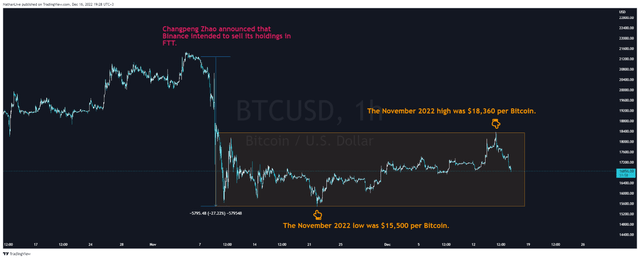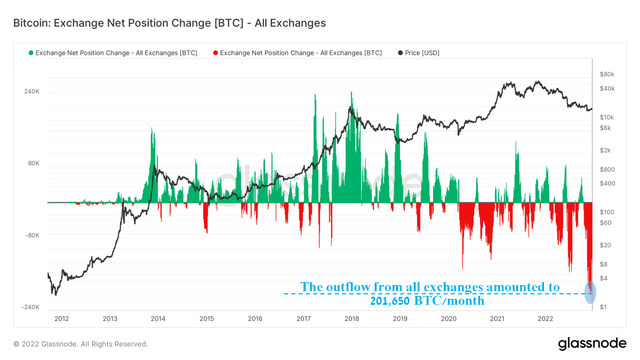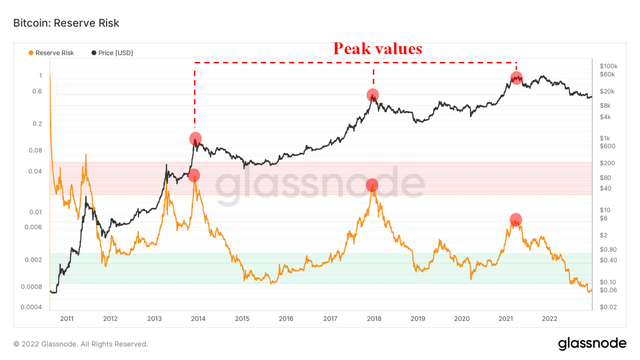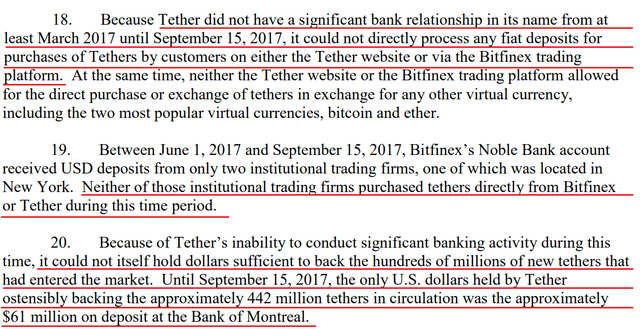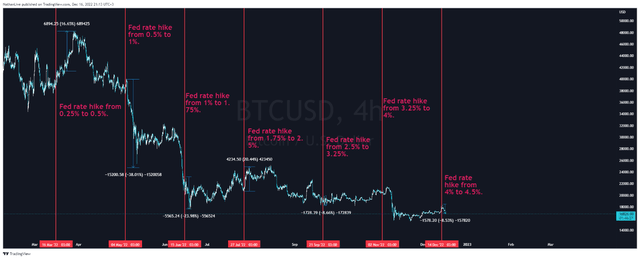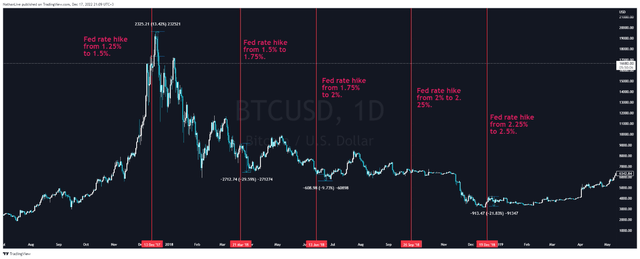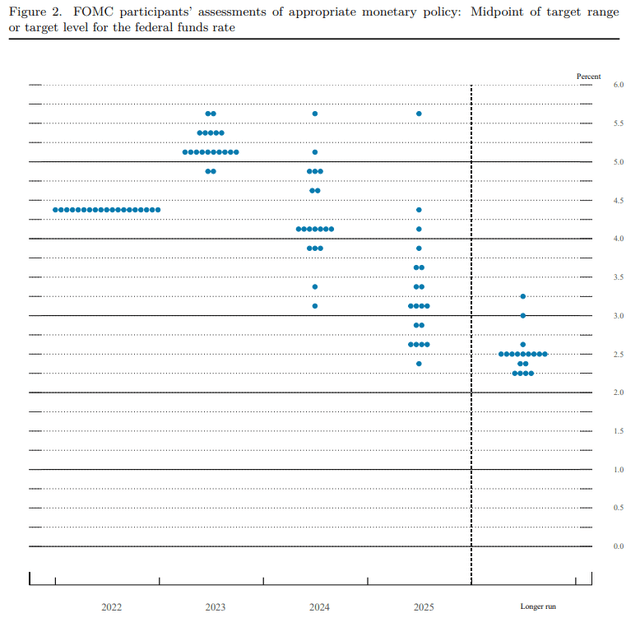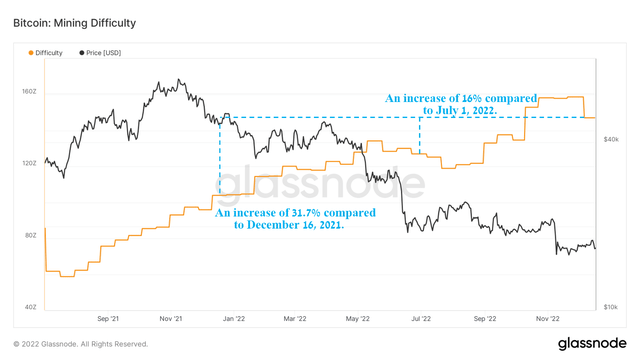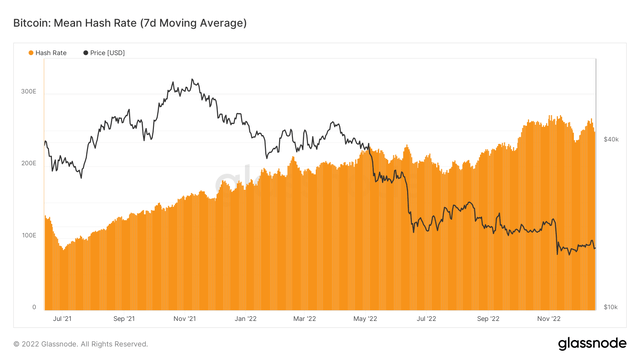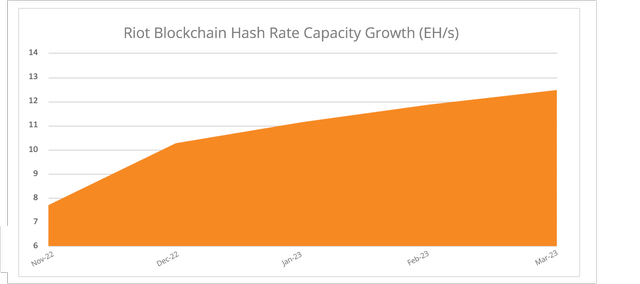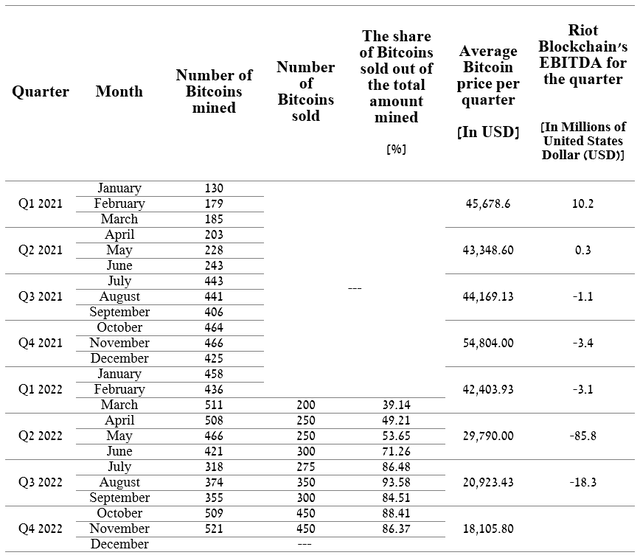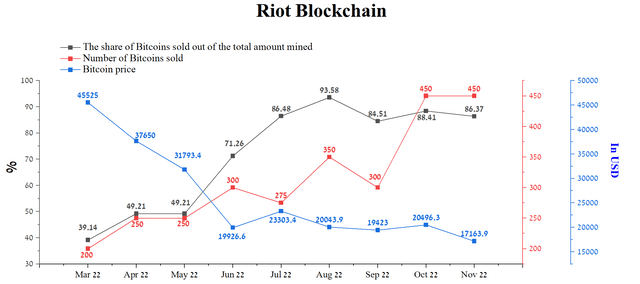ugurhan/iStock via Getty Images
A month after the collapse of the FTX (FTT-USD) cryptocurrency exchange and a month-long period of consolidation in the range of $15,500-$17,200 per Bitcoin (BTC-USD), the most popular cryptocurrency was trying to break out of the bearish trend and was trading above $18,000 for a short time. Despite the appearance of the first signs of optimism in the market, the situation began to worsen again, primarily due to news of a potential criminal case against the world’s largest crypto exchange Binance (BNB-USD), and doubts about the quality of the audit report on its reserves. As a result, on December 13, Binance customers withdrew funds in the amount of about $1.9 billion, which is one of the largest values in recent years.
At the moment, the key tasks for analysts, investors, and traders of cryptocurrencies are to determine whether the short-term period of sideways movement is just a respite before the continuation of the bearish trend or whether the situation in the market has begun to change and we can see a restart of the bull cycle again. In this article, I will present an analysis of the impact of the Fed’s interest rate hike on the crypto industry, the financial situation of miners, and the situation around Binance and Tether, which is the world’s largest stablecoin.
The situation around the largest crypto exchange Binance
More than a month has passed since the bankruptcy of one of the world’s largest cryptocurrency exchanges, FTX, but at the same time, the nervousness in society does not fade away but only intensifies. This is reflected in the withdrawal of Bitcoins from exchanges to cold wallets or their exchange for fiat currencies. In the first half of December, the rate of withdrawal of coins reached a record level of 201,650 Bitcoins per month, which has not happened since the emergence of cryptocurrencies as investment assets.
Author’s elaboration, based on Glassnode
Moreover, one of the key cyclical indicators, namely Reserve Risk, can be used to determine the ratio of risk and reward in relation to the confidence of long-term investors in Bitcoin. This indicator is able to model the relationship between the current price of an asset and investors’ confidence in its ability to rise in price in the future. At the moment, Reserve Risk continues to fall, which indicates that the panic in the market continues, which is what long-term investors take advantage of by accumulating Bitcoin. These investors are convinced of the prospects for the global use of cryptocurrencies and go against the opinion of most traders and investors looking for more conservative assets. Historically, when this indicator fell to 0.008 and below, then this period marked the presence of Bitcoin in a late bearish cycle and soon, there is a high probability of the beginning of its accumulation phase, which usually lasts from 1 to 3 months, followed by a trend change from bearish to bullish.
Author’s elaboration, based on Glassnode
Over the past five weeks, the head of Binance has been trying to improve the investment attractiveness of the crypto market and reduce the degree of tension among market participants in order to stabilize the prices of Bitcoin, Ethereum (ETH-USD), and other assets. However, as often happens, his actions only caused bewilderment and increased criticism in his direction. After the FTX crash, Changpeng Zhao is keen to demonstrate that Binance, unlike many other crypto exchanges, has the necessary reserves to cover clients’ assets and liabilities. At first, the head of Binance questioned the reserves of Coinbase (COIN), but this only slightly damaged his reputation, since Coinbase is a public company that publishes financial statements every quarter, undergoing a thorough audit.
Author’s elaboration, based on quarterly securities report
However, the financial report was too brief, it lacked information about Binance’s obligations to third parties and, most importantly, it lacked information about the issuance of Binance Coin and its use in conducting various investment activities of the company. As a result, the published superficial report only angered the crypto community and led to a multibillion-dollar outflow of assets from Binance and confused global economists responsible for auditing and financial reporting.
I believe that crypto exchange reserve reporting is still a painful topic for an industry that dates back long before the FTX crash and as a result, tougher action from regulators is needed. For example, in court cases between the New York Attorney General’s office and Tether, whose main goal is to replace the dollar to facilitate the trading of digital currencies, it was demonstrated that despite the fact that Tether (USDT-USD) is required to be fully backed by the dollar held in reserve, but that was far from the case in 2017.
Author’s elaboration, based on a settlement agreement between Tether and NYAG
As a result of the agreement reached between the two parties, in addition to a multi-million dollar fine, Tether must publish a report every quarter to make sure the main stablecoin is reliable.
Author’s elaboration, based on a settlement agreement between Tether and NYAG
As often happens, Tether’s first audit report came out clumsy and was a document containing only two charts in which there was no complete information about Tether’s reserves. Over time, the quality of reports has improved, but they are still far from the level of public companies traded on exchanges such as the Nasdaq (NDAQ), the New York Stock Exchange, and the Tokyo Stock Exchange.
I believe that the leaders of the crypto industry need to take the initiative and start hiring the most respected audit firms, giving them full access to their activities. The main reasons for this are demonstrating to Wall Street that the crypto industry has come a long way in its development and demonstrating to regulators in the US and Europe that they are willing to work together to increase people’s level of trust in cryptocurrencies.
The impact of the Fed rate hike on Bitcoin
The Fed is successfully coping with slowing inflation through continued interest rate hikes, but like any decision, there are positive and negative consequences. The downside of the Fed’s rate hike is the continued decline in the price of cryptocurrencies and continued downward pressure on the stock market as traders and investors seek to hedge against a potential recession.
In 2022, the historical chart of Bitcoin shows that its price has declined by more than 8% in most cases since the FOMC meetings, in which the decision to raise the interest rate was made. Especially significant drops in the price of Bitcoin occurred in May and June when it fell by more than 20%. The logical explanation for this trend is the increased investment attractiveness of such assets as Treasury bonds (US10Y) (US2Y), whose yields have increased significantly in recent quarters.
A similar trend occurred in 2017-2018, which only reinforces my assumption that the increase in the Fed’s interest rate is negatively reflected in high-risk assets.
On December 14, 2022, Jerome Powell stated the following during a press conference.
“But there’s an expectation, really, that the — that the services inflation will not move down so quickly, so that we’ll have to stay at it so that we may have to raise rates higher to get to where we want to go. And that’s really why we are writing down those high rates and why we’re expecting that they’ll have to remain high for a time.”
FOMC participants expect a continuation of tight monetary policy in 2023 and that the Fed’s interest rate may exceed 5%, which is a record value in recent decades.
As a result, I believe that there will be an increase in volatility among cryptocurrencies in the coming weeks and one of the most correct decisions is to reduce the number of transactions until the formation of a clearer trend, which always comes after the end of a crypto blizzard.
Financial position of crypto miners in the second half of 2022
In the second half of 2022, the difficulty of Bitcoin mining is growing relentlessly and thereby reducing the margins of crypto miners experiencing some of the most difficult periods in their history, which could result in their massive bankruptcy if the price of BTC continues to remain below the cost of its production for at least three more months. So, as of December 16, mining difficulty increased by 31.7% compared to the previous year and by 16% compared to the beginning of the 3rd quarter of 2022.
Author’s elaboration, based on Glassnode
Moreover, the competition among miners is also evident in the increase in the Bitcoin hash rate, which reached a record high of 267.4 Exahash per second, which is a 23.5% increase since July 1, 2022.
Author’s elaboration, based on Glassnode
One of the leaders in the industry, namely Riot Blockchain (RIOT), in its press release stated that the total hashing power could reach 12.5 EH/s during the first quarter of 2023, which is significantly more than the previous year.
On the one hand, this indicates the continued confidence of the company’s management and investors in the growth in asset prices, but on the other hand, this will negatively affect smaller miners, who find it more difficult to obtain the funding necessary to continue their operations.
If we consider historical trends, then the increase in network difficulty requires the largest miners to constantly increase the amount of equipment and thereby not only increases the one-time cost of their purchase but also leads to an increase in the cost of their maintenance and electricity. As a result, this negatively affects the ability of industry leaders to achieve positive EBITDA, even at times when the price of Bitcoin reaches multi-year highs. For example, in the 4th quarter of 2021, Riot’s EBITDA was -3.1 million US dollars, with an average price of Bitcoin of $54,804.
Moreover, the negative point in the conduct of Riot’s management is the fact that the share of coins that were sold from the total number of Bitcoins mined is increasing from month to month, despite the fall in their value. In other words, I believe that the effectiveness of the business model built under the leadership of Jason Les is not high, since the company has not sold Bitcoins in the volumes that have been in recent months. So, for example, Riot sold only 200 coins in March 2022, while this value increased by 125% in November 2022, but the price of Bitcoin fell 62.9%.
Conclusion
The necessary reforms in the crypto industry may be painful for certain market participants, but in the long run, more investors and traders will be able to trust crypto exchanges more. In addition, I believe in the urgent need to introduce audit control over cryptocurrency developers, as this will show how much and how investor money is spent on project development and improve the investment climate in the crypto community. As a result, more conservative investors from the stock markets will be able to begin to view coins not as just worthless assets, but as something that has the potential to improve certain aspects of people’s lives.
The crypto miner business continues to suffer from a months-long “crypto winter” as the cost of mining Bitcoin exceeds its current price. But even during periods of mass euphoria, when the growth in the price of the most popular coin significantly exceeded the growth rate of the S&P 500 (SPY), the EBITDA of one of the industry leaders, namely Riot Blockchain, remained in the negative zone. The key reasons for this can be not only the inefficiency of the business model but also the inability of companies from the crypto industry to increase the hash rate faster than the growth rate of network difficulty.
In general, I believe that as soon as news begins to appear signaling a reduction in the Fed interest rate, this will become one of the main triggers that can lead to a significant increase in investment interest not only in cryptocurrencies but also in shares of companies traded with a beta greater than 1 and increased financial ratios. According to my model, the Fed’s rhetoric will not begin to soften in the next two quarters, and as a result, I maintain the expectation that the Bitcoin price bottom will be in the $12,700-$13,600 range and will occur in early 2023. However, before that, we are waiting for an increase in volatility in the crypto market, and novice investors should be most careful in making decisions.



